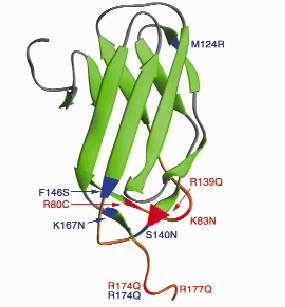Runt domains take the lead in hematopoiesis and osteogenesis (original) (raw)
- News & Views
- Published: December 1999
Nature Medicine volume 5, pages 1356–1357 (1999)Cite this article
- 159 Accesses
- 22 Citations
- Metrics details
Abstract
It has been nearly a decade since AML1 was first identified as the DNA-binding protein PEBP2αB/CBFA2 in mice. Molecular, genetic and biochemical studies have converged to reveal new information about how this unique family of transcription factors functions, and the linkage between developmental processes and human disease.
This is a preview of subscription content, access via your institution
Access options
Subscribe to this journal
Receive 12 print issues and online access
$209.00 per year
only $17.42 per issue
Buy this article
- Purchase on SpringerLink
- Instant access to full article PDF
Prices may be subject to local taxes which are calculated during checkout
Additional access options:
Figure 1: Three-dimensional structure of the Runt domain and location of mutations causing deficiencies in DNA binding associated with AML, FPD and CCD.

References
- Look, A.T. Oncogenic transcription factors in the human acute leukemias. Science 278, 1059–1064 (1997).
Article CAS PubMed Google Scholar - Song, W.J. et al. Haploinsufficiency of CBFA2 causes familial thrombocytopenia with propensity to develop acute myelogenous leukaemia. Nature Genet. 23, 166–174 (1999).
Article CAS PubMed Google Scholar - Osato, M. et al. Biallelic and heterozygous point mutations in the runt domain of the AML1/PEBP2αB gene associated with myeloblastic leukemias. Blood 93, 1817–1824. (1999).
CAS PubMed Google Scholar - Rodan, G.A. & Harada, S-I. The missing bone. Cell 89, 6777–680 (1997).
Article Google Scholar - Lee, B. et al. Missense mutations abolishing DNA binding of the osteoblast-specific transcription factor OSF2/CBFA1 in cleidocranial dysplasia. Nature Genet. 16, 307–310 (1997).
Article CAS PubMed Google Scholar - Mundlos, S. et al. Mutations involving the transcription factor CBFA1 cause cleidocranial dysplasia. Cell 89, 773–779 (1997).
Article CAS PubMed Google Scholar - Zhang, Y-W. et al. PEBP2αA/CBFA1 mutations in Japanese cleidocranial dysplasia patients. Gene (in the press).
- Nagata, T. et al. Immunoglobulin motif DNA recognition and heterodimerization of the PEBP2/CBF Runt domain. Nature Struct. Biol. 6, 615–619 (1999).
Article CAS PubMed Google Scholar - Goger, M. et al. Molecular insights into PEBP2/CBFβ-SMMHC associated acute leukemia revealed from the structure of PEBP2/CBFβ Nature Struct. Biol. 6, 620–623 (1999).
- Huang, X. et al. Solution structure of CBFβ and a map of the CBFα binding site. Nature Struct. Biol. 6, 624–627 (1999).
Article CAS PubMed Google Scholar - Berardi, M.J. et al. The Ig fold of the core binding factor α Runt domain is a member of a family of structurally and functionally related Ig-fold DNA-binding domains. Structure 7, 1247–137 (1999).
Article CAS PubMed Google Scholar - Wang, Q. et al. Disruption of the CBFA2 gene causes necrosis and hemorrhaging in the central nervous system and blocks definitive hematopoiesis. Proc. Natl. Acad. Sci. USA 93, 3444–3449 (1996).
Article CAS PubMed PubMed Central Google Scholar - Okuda, T. et al. AML1, the target of multiple chromosomal translocations in human leukemia, is essential for normal fetal liver hematopoiesis. Cell 84, 321–330 (1996).
Article CAS PubMed Google Scholar - Hanai, J. et al. Interaction and functional cooperation of PEBP2/CBF with Smads. J. Biol. Chem. 274, 31577–31582 (1999).
Article CAS PubMed Google Scholar - Knudson, A.G. Jr. Mutation and cancer: statistical study of retinoblastoma. Proc. Natl. Acad. Sci. USA 68, 820–823 (1971).
Article PubMed PubMed Central Google Scholar - Fero, M.L. et al. The murine gene p27_Kip1_ is haplo-insufficient for tumour suppression. Nature 396, 177–180 (1998).
Article CAS PubMed PubMed Central Google Scholar
Author information
Authors and Affiliations
- Laboratory of Molecular Biophysics The Rockefeller University, 1230 York Avenue, New York, 10021, New York, USA
Milton H. Werner - Departments of Viral Oncology, Genetics and Molecular Biology, Institute for Virus Research, Kyoto University, Sakyo-ku, 606, Kyoto, Japan
Katsuya Shigesada & Yoshiaki Ito
Authors
- Milton H. Werner
You can also search for this author inPubMed Google Scholar - Katsuya Shigesada
You can also search for this author inPubMed Google Scholar - Yoshiaki Ito
You can also search for this author inPubMed Google Scholar
Rights and permissions
About this article
Cite this article
Werner, M., Shigesada, K. & Ito, Y. Runt domains take the lead in hematopoiesis and osteogenesis.Nat Med 5, 1356–1357 (1999). https://doi.org/10.1038/70920
- Issue Date: December 1999
- DOI: https://doi.org/10.1038/70920